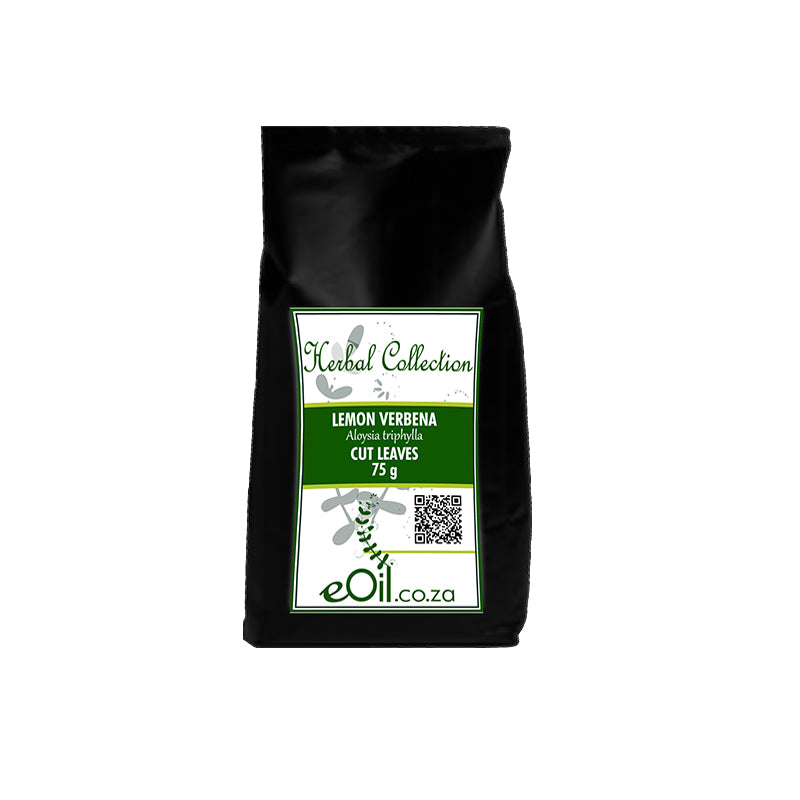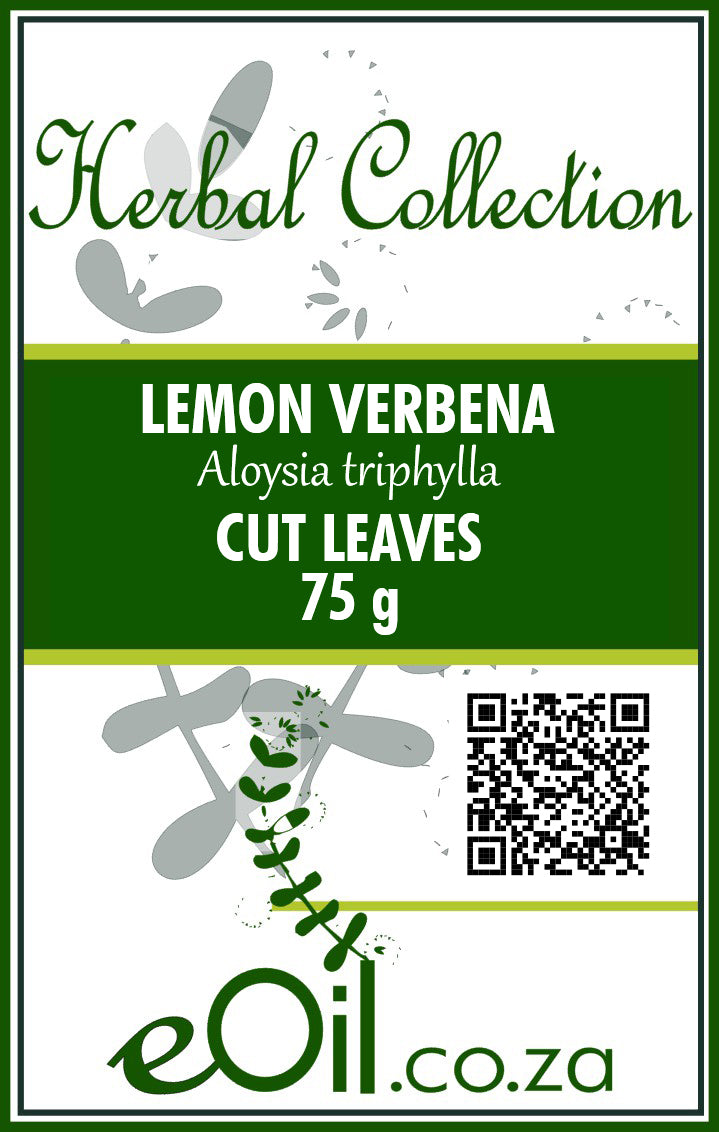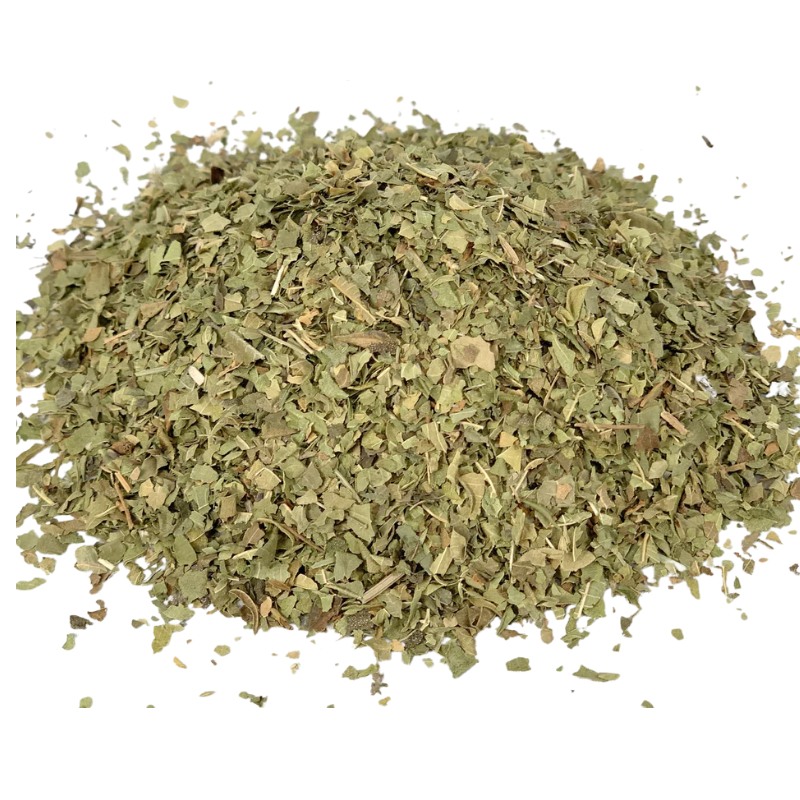Lemon verbena dried cut - Herbal Collection
Lemon verbena dried cut - Herbal Collection - 75 GR is backordered and will ship as soon as it is back in stock.
Description
Description
Aloysia triphylla | Lippia citriodora
Dried Lemon Verbena Cut is one of the most popular of herbs used to make tea.
TRADITIONALLY USED FOR
The tea is refreshing but slightly sour, and is said to improve digestion, joint pain and helps in asthma.
It’s also a mild sedative and tonic for the nervous system.
INFORMATION
Source : http://www.wikiphyto.org/wiki/Verveine_odorante
Reference on http://www.wikiphyto.org
Translation in English by Google Translate (go to the page of the source linked | on Chrome cellphones go on the 3 dots on the top right and select translate in your preferred language | on laptop right click your mouse and select option translate when hoovering on the page
plant name
Lemon Verbena , Lemon Verbena , Lemon Verbena
International Latin denomination
Aloysia citrodora Palau; syn.: Lippia citriodora Kunth, Aloysia triphylla (L'Hérith.) Britt., Verbena triphylla , Lippia triphylla
botanical family
Verbenaceae
Description and habitat
- Fragrant shrub up to 2 m, with fluted, branched angular stem
- Leaves in whorls of 3 or 4, lanceolate, pinnate, with protruding vein below, exhaling a lemony odor when crushed
- Spikes of many small white and bluish flowers whose tube flares out into a star of 4 lobes
History and tradition
- Spontaneous in South America, originating in Chile
- Introduced in southern Europe and North Africa
- It owes its name to the traveling botanist Lipp
Parts used
- Leaf
- leaf essential oil
Dosage forms available
- Essential oil
- Dried aerial part
Usual dosages
Composition
Main components of the plant
- Essential oil with citrals ( EO content from 0.08% to 0.20% for the whole plant and double for the leaves)
- Mucilage , tannins
- Iridoids ( verbenalin )
- Flavonoids : luteolin 7-diglucuronide
- Verbascoside (= acteoside ) [1]
- Polyphenols , flavonoids : vitexin , luteolin-7-O-glucoside , apigenin-7-O-glucoside , flavones and their derivatives ( salvigenin , eupafolin , hispidulin , etc.)
Main components of buds or young shoots
Main components of essential oil
- More than 120 constituents
- Monoterpene aldehydes : citrals (20-40%), geranial ( citral a ): 15-25% and neral ( citral b ): 10-20%, citronellal (15-20%), photocitral
- Monoterpenes : limonene 10 to 20%, sabinene
- Monoterpene alcohols : geraniol , nerol , alpha-terpineol , geraniol
- Sesquiterpenes : ar-curcumene , beta-caryophyllene , bicyclogermacrene (2.48%), beta-curcumene , germacrene-D
- Sesquiterpene alcohols : spathulenol , (E)-nerolidol
- Oxides : 1,8-cineole , caryophyllene oxide
- Ketones : verbenone
Properties
Plant properties
- Powerful antioxidant, antiradical [2] , antigenotoxic [3]
- Powerfully spasmolytic on isolated ileum [4] , protective against colonic inflammation [5]
- Analgesic activity (aqueous extracts) [6]
- Ethanolic extracts are anticonvulsants by activity on the GABA system [7]
- Anti-microbial, cytotoxic [8]
- Ethanolic extracts are cytotoxic against Helicobacter pylori [9]
- Anti-histamine
- Anxiolytic activity [10]
- Traditional use (in Reunion) in fever, flu, cough, migraines, malaise, dizziness
- Facilitates sleep, fights anguish and anxiety
- Geranial and neral monoterpene aldehydes are calming of the central nervous system and slightly toning, antiviral (flu)
Bud properties
Properties of essential oil
- Sedative, antidepressant
- Mildly analgesic and anti-neuralgic
- Spasmolytic and anti-histamine (inhibition of histamine release) [11]
- Anti-inflammatory
- Digestive
- Antiviral ( Herpes ) [12]
- Anti- Helicobacter pylori [13]
- Inducer of apoptosis in chronic lymphoid leukemias (activation of caspase-3) [14]
- The essential oil of Lippia multiflora would be scabicidal, usable in the treatment of scabies [15] , with good tolerance
Directions
Indications of the whole plant (phytotherapy)
- Digestive spasms and gastralgia
- Fever, flu, cough
- Migraines, malaise, dizziness
- Sleeping troubles
- Combat anxiety and anxiety
- Weight gain, obesity [16]
Indications of the bud (gemmotherapy)
Specific indications of essential oil (aromatherapy)
- Depressive states, anxiety, stress
- Rheumatism, tendonitis
- Digestive spasms, spasmophilia, tachycardia
- Cancers ( monoterpene aldehydes ), chronic lymphocytic leukemia CLL (?)
Known or suspected mode of action
- Geranial and neral monoterpene aldehydes are calming of the central nervous system and slightly toning, anti-cancer
- Neral would be an antidepressant
Usual formulations
Regulations
- French Pharmacopoeia list A (sheet)
Possible side effects and precautions for use
- HE contraindicated during pregnancy
- Possible dermocausticity
- Allergic risk with citrals and limonene
- Risk of photosensitization with EO , avoid sun exposure
Bibliographic references
- Go↑ A Carnat, AP Carnat, D Fraisse, JL Lamaison. The aromatic and polyphenolic composition of lemon verbena tea. Fitoterapia, Volume 70, Issue 1, 1 February 1999, Pages 44–49 [1]
- Go↑ Valentão P, Fernandes E, Carvalho F, Andrade PB, Seabra RM, de Lourdes Basto M. Studies on the antioxidant activity of Lippia citriodora infusion: scavenging effect on superoxide radical, hydroxyl radical and hypochlorous acid. Biol Pharm Bull. 2002 Oct;25(10):1324-7. PMID 12392088
- Go↑ Zamorano-Ponce E, Fernandez J, Vargas G, Rivera P, Carballo MA. Protective activity of cedron (Aloysia triphylla) infusion over genetic damage induced by cisplatin evaluated by the comet assay technique. Toxicol Lett. 2004 Aug 30;152(1):85-90. PMID 15294350
- Go↑ Ragone MI, Sella M, Conforti P, Volonté MG, Consolini AE. The spasmolytic effect of Aloysia citriodora, Palau (South American cedrón) is partially due to its vitexin but not isovitexin on rat duodenums. J Ethnopharmacol. 2007 Sep 5;113(2):258-66. PMID 17640836
- Go↑ Loic Lenoir. Protective effect of lemon verbena polyphenols in a model of colonic inflammation in rats. University thesis, University of Auvergne - Clermont-Ferrand I (11/07/2011), Catherine Felgines (Dir.) full text
- Go↑ Veisi, M., Shahidi, S., Komaki, A. et al. Analgesic Effects of the Aqueous Lemon Verbena Extract in Rats. Neurophysiology 48, 107–110 (2016). https://doi.org/10.1007/s11062-016-9575-9
- Go↑ Rashidian A, Farhang F, Vahedi H, Dehpour AR, Ejtemai Mehr S, Mehrzadi S, Rezayat SM. Anticonvulsant effects of Lippia citriodora (Verbenaceae) leaves ethanolic extract in mice: Role of gabaergic system. Int J Prev Med 2016;7:97
- Go↑ Mothana RA, Abdo SA, Hasson S, Althawab FM, Alaghbari SA, Lindequist U. Antimicrobial, Antioxidant and Cytotoxic Activities and Phytochemical Screening of Some Yemeni Medicinal Plants. Evid Based Complement Alternate Med. 2008 Jan 28. PMID 18955315
- Go↑ Masadeh MM, Alkofahi AS, Alzoubi KH, Tumah HN, Bani-Hani K. Anti-Helicobactor pylori activity of some Jordanian medicinal plants. Pharm Biol. 2014 May;52(5):566-9. doi: 10.3109/13880209.2013.853811. PMID 24251817
- Go↑ Veisi M, Shahidi S, Komaki A, Sarihi A. Assessment of aqueous extract of Lemon verbena on anxiety-like behavior in rats. J Pharm Negative Results [serial online] 2015 [cited 2016 Aug 20];6:37-9. Available from: http://www.pnrjournal.com/text.asp?2015/6/1/37/157390
- Go↑ Teuscher Eberhard, Anton Robert, Lobstein Annelise. Aromatic plants: Spices, herbs, condiments and essential oils. Ed. Tec & Doc. Cachan. 2005.
- Go↑ Duschatzky, CB, Possetto, ML, Talarico, LB, García, CC, Michis, F., Almeida, NV, de Lampasona, MP, Schuff, C., & Damonte, EB (2005). Evaluation of chemical and antiviral properties of essential oils from South American plants. Antiviral Chemistry & Chemotherapy, 16(4), 247–251. https://doi.org/10.1177/095632020501600404 . PMID 16130522
- Go↑ Ohno T, Kita M, Yamaoka Y, Imamura S, Yamamoto T, Mitsufuji S, Kodama T, Kashima K, Imanishi J. Antimicrobial activity of essential oils against Helicobacter pylori. Helicobacter. 2003 Jun;8(3):207-15. PMID 12752733
- Go↑ De Martino L, D'Arena G, Minervini MM, Deaglio S, Fusco BM, Cascavilla N, De Feo V. Verbena officinalis essential oil and its component citral as apoptotic-inducing agent in chronic lymphocytic leukemia. Int J Immunopathol Pharmacol. 2009 Oct-Dec;22(4):1097-104. PMID 20074474
- Go↑ FA Oladimeji, LO Orafidiya, TAB Ogunniyi, TA Adewunmi, O. Onayemi. A comparative study of the scabicidal activities of formulations of essential oil of Lippia multiflora Moldenke and benzyl benzoate emulsion BP. International Journal of Aromatherapy, Volume 15, Issue 2, 2005, Pages 87-93 https://doi.org/10.1016/j.ijat.2005.03.005
- Go↑ Herranz-López M, Barrajón-Catalán E, Segura-Carretero A, Menéndez JA, Joven J, Micol V. Lemon verbena (Lippia citriodora) polyphenols alleviate obesity-related disturbances in hypertrophic adipocytes through AMPK-dependent mechanisms. Phytomedicine. 2015 Jun 1;22(6):605-14. doi: 10.1016/j.phymed.2015.03.015. PMID 26055125
- Bézanger-Beauquesne, Pinkas, Torck, Trottin. Medicinal plants of temperate regions. Ed. Maloine. Paris. 1980. p. 315.
- Patel R, Garg R, Erande S, and Maru G B. Chemopreventive herbal anti-oxidants: current status and future perspectives. J Clin Biochem Nutr. 2007 March; 40(2): 82–91.
- Connor MJ. Modulation of tumor promotion in mouse skin by the food additive citral (3,7-dimethyl-2,6-octadienal). Cancer Lett. 1991 Jan;56(1):25-8.
- Pascual ME, Slowing K, Carretero E, Sánchez Mata D, Villar A. Lippia: traditional uses, chemistry and pharmacology: a review. J Ethnopharmacol. 2001 Aug;76(3):201-14. PMID 11448540
- Tela Botanica [2]
CAUTION
Store in a cool, dry place, away from light. Keep tightly closed, away from the reach of Children and pets.
Do not exceed the daily dose.
This product is not intended to prevent or cure any form of illness or disease.
If you are pregnant or nursing ; If you have a medical condition or are in the course of medical treatment ; If you are programmed for theater/operation in the near future, please consult your healthcare practitioner before using this product.
This product cannot replace a varied and balanced diet and a healthy lifestyle.
This product has not been evaluated by the SAHPRA for its quality, safety or intended use.
For More Information please check our General Safety Herbal products Page

Lemon verbena dried cut - Herbal Collection - 75 GR is backordered and will ship as soon as it is back in stock.






